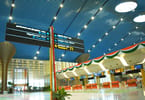SINGAPORE — Casey Chan used to fly business class every other month to oversee his company’s electronics factory in China until late last year, when orders from Western buyers suddenly started drying up.
His employer, a Singapore-based multinational firm that makes components for items like DVD players and digital cameras, is unlikely to put him back on a plush airline seat, with fine wines on demand, anytime soon.
“My company is keeping a very tight control on cost now,” said the Singaporean chief engineer, who has not flown to China since January and now spends most of his time in the head office here with little work to do.
Business-class travel cutbacks by Chan and thousands of other executives as a result of the global financial crisis have dealt a major blow to airlines, with those in the Asia-Pacific region particularly hard hit, industry experts said.
Carriers like Singapore Airlines (SIA) are seen as the most vulnerable because they have poured extensive resources into business- and first-class travel, known as premium traffic.
This is where Asia-Pacific carriers earn the bulk of their revenues and the dramatic fall in demand is devastating their bottom lines.
“It will be very difficult for any Asia Pacific carriers to make money in 2009,” said Derek Sadubin, chief operating officer with the Sydney-based Centre for Asia Pacific Aviation.
Premium traffic demand is down by 15-30 percent on average depending on the route, he said.
The situation is far worse than last year’s turbulence when fuel prices soared to record levels, the aftermath of the September 2001 terror attacks in the United States, or the SARS outbreak in 2003, Sadubin added.
As a result, carriers have resorted to “taking extraordinary measures to preserve cash” including grounding planes and asking cabin crew to take unpaid leaves.
“After 9/11 and after SARS, the industry came back quite quickly because the economic cycle was stronger, but now we have a deep global recession that has impacted corporate travel, which collapsed subsequently,” he said.
The International Air Transport Association (IATA) said premium traffic within the region shrank 26.4 percent in February from a year ago, worse than the 23.4 percent recorded in January.
IATA last month predicted the region would emerge as the world’s worst hit 2009, with collective losses of 1.7 billion US dollars, higher than the 1.1-billion dollar loss it forecast previously.
Globally, the industry will likely lose 4.7 billion dollars compared with the earlier forecast of 2.5 billion dollars, said IATA.
Giovanni Bisignani, IATA’s director-general, said last month that “2009 is shaping out to be the toughest year that (the) airline industry has ever faced.”
He noted that the three biggest Asian economies — Japan, China and India — are all badly affected by the global downturn.
Jim Eckes, managing director with the Hong Kong-based consultancy Indoswiss Aviation, sees the next three years as very tough for the premium carriers.
“Asian airlines have a reputation for quality premium service so naturally they are going to be affected more by the fall in high-yield traffic,” said Eckes.
SIA’s operating statistics show the carrier flew 23 percent fewer passengers in March from a year ago.
It has reduced the frequency of its all-business-class direct flights to New York and Los Angeles from daily to five times a week.
The carrier’s main rivals in the region have also announced cost-cutting measures.
Australia’s Qantas announced new job cuts of up to 1,750 and slashed its full-year profit forecast to 73 million to 146 million US dollars, from the 363 million dollars it had predicted in November.
Hong Kong’s Cathay Pacific, which lost more than one billion dollars last year, is also looking at ways to cut costs, including reducing some routes.
One non-Asian carrier hit by the fall in premium traffic is Swiss International Air Lines (SWISS), which will be pulling the plug on its Singapore-Bangkok-Zurich service on April 26.
“Singapore and Zurich are two of the most important financial centres in the world so obviously most of our premium travellers are from the financial sector,” said Markus Schmid, the carrier’s regional head.
WHAT TO TAKE AWAY FROM THIS ARTICLE:
- Business-class travel cutbacks by Chan and thousands of other executives as a result of the global financial crisis have dealt a major blow to airlines, with those in the Asia-Pacific region particularly hard hit, industry experts said.
- The situation is far worse than last year’s turbulence when fuel prices soared to record levels, the aftermath of the September 2001 terror attacks in the United States, or the SARS outbreak in 2003, Sadubin added.
- One non-Asian carrier hit by the fall in premium traffic is Swiss International Air Lines (SWISS), which will be pulling the plug on its Singapore-Bangkok-Zurich service on April 26.






















